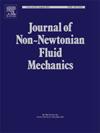用于聚合物诱导/修正湍流直接数值模拟的高保真算法的GPU加速
IF 2.8
2区 工程技术
Q2 MECHANICS
引用次数: 0
摘要
本文利用开源有限差分不可压缩Navier-Stokes解算器can,提出了一种高效的GPU实现,用于聚合物诱导/修改湍流的直接数值模拟(DNS)。该实现包含一个通用粘弹性求解器,用于弹性或弹性修正湍流的DNS中两种常用的本构方程,即FENE-P和Giesekus模型。与can一致,粘弹性求解器使用CUDA Fortran,并广泛使用内核循环指令(CUF内核)。为了提高该实现的保真度和鲁棒性,采用基于张量的插值方法结合冲击捕获WENO方案对聚合物本构方程进行空间离散化。通过与已有的理论和仿真结果的比较,验证了本文代码的准确性和鲁棒性。此外,该算法在基准通道流中显示了多达8个Nvidia GPU设备的卓越可扩展性。反过来,我们使用该快速代码进行粘弹性湍流的高保真和高效的大规模DNS。为此,我们证明了我们的实现在一系列聚合物诱导/修改的通道流动湍流中的广泛适用性。这包括最大减阻渐近线,以及弹性惯性湍流和纯弹性湍流。总的来说,这种gpu加速模拟技术具有成为大规模粘弹性计算的首选方法所需的所有成分,旨在忠实地捕获聚合物诱导的流动现象。本文章由计算机程序翻译,如有差异,请以英文原文为准。
GPU acceleration of a hi-fidelity algorithm for direct numerical simulation of polymer-induced/modified turbulence
This paper presents an efficient GPU implementation for the direct numerical simulation (DNS) of polymer-induced/modified turbulence, utilizing the open-source finite-difference incompressible Navier–Stokes solver, . The implementation incorporates a versatile viscoelastic solver for two commonly used constitutive equations in DNS of elastic or elastically modified turbulence, namely, the FENE-P and the Giesekus models. Consistent with , the viscoelastic solver uses CUDA Fortran and makes extensive use of kernel loop directives (CUF kernels). To improve the fidelity and robustness of this implementation, a tensor-based interpolation method combined with a shock-capturing WENO scheme is employed for spatial discretization of the polymer constitutive equations. We demonstrate the accuracy and robustness of our code by comparison with existing theoretical and simulation results. In addition, the algorithm exhibits superior scalability with up to eight Nvidia GPU devices in benchmark channel flows. In turn, we use this expeditious code for high-fidelity and efficient large-scale DNS of viscoelastic turbulent flows. To that end, we demonstrate the broad applicability of our implementation in a host of polymer-induced/modified turbulence in channel flows. This includes the maximum drag reduction asymptote, as well as elasto-inertial turbulence, and purely elastic turbulent flows. Overall, this GPU-accelerated simulation technique has all the required ingredients to become the method of choice for large-scale viscoelastic computations aimed at faithfully capturing polymer-induced flow phenomena.
求助全文
通过发布文献求助,成功后即可免费获取论文全文。
去求助
来源期刊
CiteScore
5.00
自引率
19.40%
发文量
109
审稿时长
61 days
期刊介绍:
The Journal of Non-Newtonian Fluid Mechanics publishes research on flowing soft matter systems. Submissions in all areas of flowing complex fluids are welcomed, including polymer melts and solutions, suspensions, colloids, surfactant solutions, biological fluids, gels, liquid crystals and granular materials. Flow problems relevant to microfluidics, lab-on-a-chip, nanofluidics, biological flows, geophysical flows, industrial processes and other applications are of interest.
Subjects considered suitable for the journal include the following (not necessarily in order of importance):
Theoretical, computational and experimental studies of naturally or technologically relevant flow problems where the non-Newtonian nature of the fluid is important in determining the character of the flow. We seek in particular studies that lend mechanistic insight into flow behavior in complex fluids or highlight flow phenomena unique to complex fluids. Examples include
Instabilities, unsteady and turbulent or chaotic flow characteristics in non-Newtonian fluids,
Multiphase flows involving complex fluids,
Problems involving transport phenomena such as heat and mass transfer and mixing, to the extent that the non-Newtonian flow behavior is central to the transport phenomena,
Novel flow situations that suggest the need for further theoretical study,
Practical situations of flow that are in need of systematic theoretical and experimental research. Such issues and developments commonly arise, for example, in the polymer processing, petroleum, pharmaceutical, biomedical and consumer product industries.

 求助内容:
求助内容: 应助结果提醒方式:
应助结果提醒方式:


